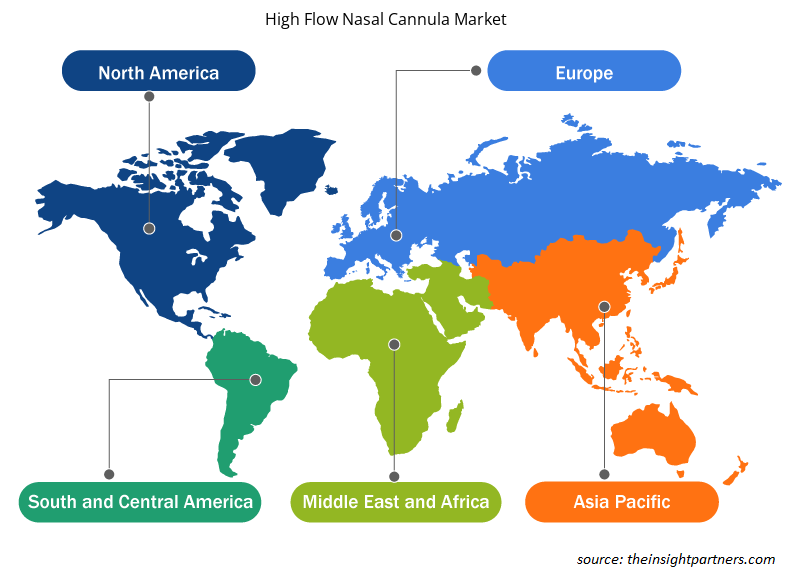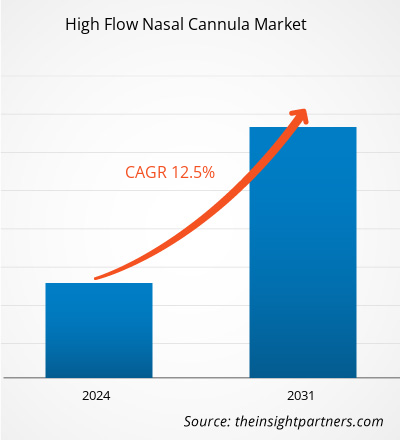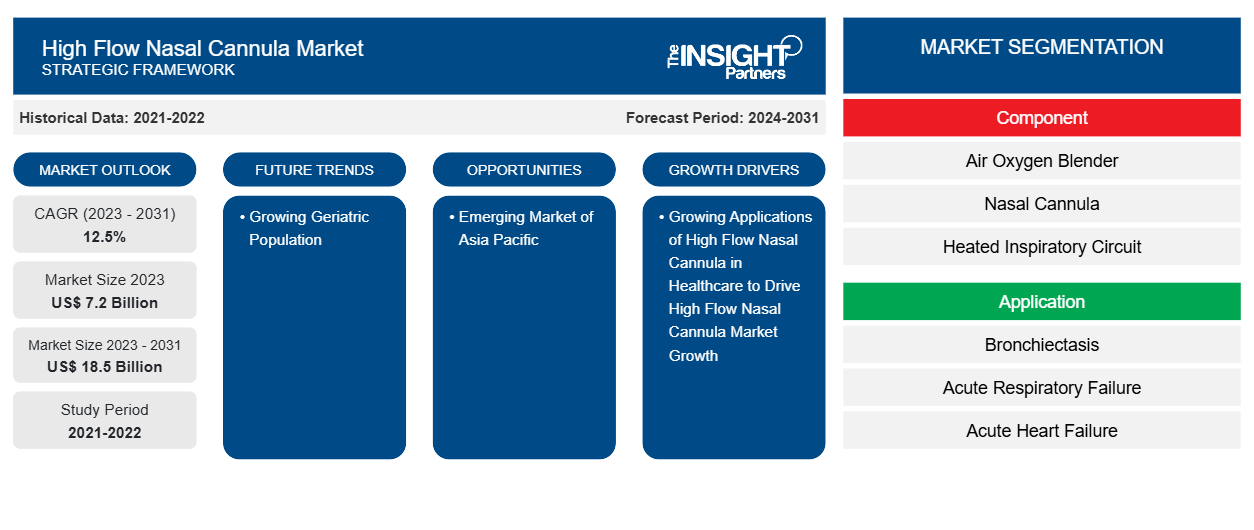Der Markt für High-Flow-Nasenkanülen soll von 7,2 Milliarden US-Dollar im Jahr 2023 auf 18,5 Milliarden US-Dollar im Jahr 2031 anwachsen. Der Markt wird zwischen 2023 und 2031 voraussichtlich eine durchschnittliche jährliche Wachstumsrate von 12,5 % verzeichnen. Die weltweit steigende Zahl von Asthma und COPD, die steigende Zahl geriatrischer Menschen und das Wachstum der Medizin in Schwellenländern werden voraussichtlich weiterhin wichtige Trends auf dem Markt bleiben.
Marktanalyse für Nasenkanülen mit hohem Durchfluss
Die Zahl der Asthma- und COPD-Fälle ist weltweit stark gestiegen. In den letzten Jahren haben die Zahl der Raucher und die Luftverschmutzung in Industrie- und Entwicklungsländern weltweit zugenommen. Asthma ist eine Erkrankung, bei der die Atemwege anschwellen und sich verengen und Schleim produzieren. Dies führt außerdem zu Keuchen, Husten und wiederkehrenden Atemnotanfällen, deren Schwere und Häufigkeit von Person zu Person unterschiedlich ist. Nach Schätzungen der Weltgesundheitsorganisation leiden weltweit etwa 235 Millionen Menschen an Asthma. Darüber hinaus berichteten die Centers for Disease Control and Prevention (CDC), dass derzeit etwa 19 Millionen Erwachsene (ab 18 Jahren) in den Vereinigten Staaten an Asthma leiden, was fast 7,7 % der gesamten erwachsenen Bevölkerung ausmacht. Während etwa 6,2 Millionen Patienten unter 18 Jahren an Asthma leiden, was 8,4 % der gesamten Kinderbevölkerung ausmacht.
Marktübersicht für High-Flow-Nasenkanülen
Die wichtigsten Faktoren, die das Wachstum des Marktes vorantreiben, sind die weltweit steigenden Fälle von Asthma und COPD sowie die steigende Zahl geriatrischer Menschen. Die mit der Verwendung von High-Flow-Nasenkanülen verbundenen Nebenwirkungen dürften jedoch das Wachstum des Marktes hemmen. Schätzungen zufolge wird der Markt für High-Flow-Nasenkanülen in den Vereinigten Staaten einen größeren Anteil haben. Das Wachstum des Marktes für High-Flow-Nasenkanülen in den Vereinigten Staaten dürfte aufgrund der steigenden Zahl von Atemwegserkrankungen sowie der Präsenz von Marktteilnehmern, die innovative Lösungen auf dem Markt anbieten, zunehmen. Fisher & Paykel Healthcare Limited und ResMed gehören zu den Akteuren, die einen bedeutenden Anteil am globalen Markt für High-Flow-Nasenkanülen halten. So erwarb ResMed im März 2019 HB Healthcare (HBH), um Millionen Südkoreanern zu helfen, die mit Schlafapnoe, chronisch obstruktiver Lungenerkrankung (COPD) und anderen Atemwegserkrankungen leben.
Passen Sie diesen Bericht Ihren Anforderungen an
Sie erhalten kostenlos individuelle Anpassungen an jedem Bericht, einschließlich Teilen dieses Berichts oder einer Analyse auf Länderebene, eines Excel-Datenpakets sowie tolle Angebote und Rabatte für Start-ups und Universitäten.
-
Holen Sie sich die wichtigsten Markttrends aus diesem Bericht.Dieses KOSTENLOSE Beispiel umfasst eine Datenanalyse von Markttrends bis hin zu Schätzungen und Prognosen.
Markttreiber und Chancen für High-Flow-Nasenkanülen
Steigendes COPD-Risiko bei geriatrischer Bevölkerung begünstigt den Markt
COPD und Asthma sind Alterskrankheiten, die zu schleichenden Komplikationen führen. Laut der Asthma and Allergy Foundation of America (AAFA) ist Asthma bei älteren Menschen eine kritische Erkrankung, die oft unbemerkt bleibt. Laut dem Office of Disease Prevention and Health Promotion (ODPHP) leiden in den USA etwa 23 Millionen Menschen an irgendeiner Form von Asthma, die meisten davon sind ältere Menschen. Ältere Menschen mit Asthma benötigen trotz leichter Asthmaanfälle oft hohe Medikamentendosen. Daher erleiden sie im Vergleich zur jüngeren Bevölkerung viel schneller Atemversagen. Außerdem kann COPD in jedem Alter auftreten. Es ist jedoch bei älteren Menschen häufiger und kann tödlich sein. Die alternde Bevölkerung wächst weltweit exponentiell.
Durchdringung des Marktes durch moderne medizinische Versorgung in Schwellenländern
Die wachsende Gesundheitsbranche in den Entwicklungsländern im asiatisch-pazifischen Raum schafft bessere Möglichkeiten für bedeutende Marktteilnehmer, ihre Geschäfte auszuweiten. Dies ist ein wichtiger Grund für das Marktwachstum im Prognosezeitraum. Die meisten großen Akteure konzentrieren sich auf Schwellenmärkte wie Indien, China und andere, da dort viele Patienten mit Atemwegserkrankungen leben und der Medizintourismus in den Entwicklungsländern zunimmt. Viele der Schwellenländer sind bevorzugte Standorte für den Medizintourismus. Laut den Daten zur globalen Krankheitslast hat Indien 18 % der Weltbevölkerung, aber 32 % der globalen Belastung durch Atemwegserkrankungen des globalen Marktanteils bei Nasenkanülen.
High Flow Nasenkanüle Marktbericht Segmentierung Analyse
Wichtige Segmente, die zur Ableitung der Marktanalyse für High-Flow-Nasenkanülen beigetragen haben, sind Produkte und Dienstleistungen, Anwendungen und Endbenutzer.
- Basierend auf Produkten und Dienstleistungen ist der Markt für High-Flow-Nasenkanülen in Dienstleistungen, Verbrauchsmaterialien und Software unterteilt. Das Dienstleistungssegment hatte im Jahr 2023 einen größeren Marktanteil.
- Der Markt ist nach Anwendung in Forschungs- und Entwicklungsaktivitäten, Diagnostik, Therapeutika und andere unterteilt. Das Segment Forschungs- und Entwicklungsaktivitäten hatte im Jahr 2023 den größten Marktanteil.
- In Bezug auf die Endverbraucher ist der Markt in akademische und Forschungsinstitute, Biotech- und Pharmaunternehmen, Diagnoselabore und andere unterteilt. Das Segment der akademischen und Forschungsinstitute hielt im Jahr 2023 einen erheblichen Marktanteil.
High Flow Nasal Cannulum Marktanteilsanalyse nach Geografie
Der geografische Umfang des Marktberichts für Nasenkanülen mit hohem Durchfluss ist hauptsächlich in fünf Regionen unterteilt: Nordamerika, Asien-Pazifik, Europa, Naher Osten und Afrika sowie Süd- und Mittelamerika. Nordamerika hat den größten Marktanteil am Markt für Nasenkanülen mit hohem Durchfluss nach geografischer Lage. Faktoren wie die Prävalenz von Atemwegserkrankungen und das Vorhandensein vielversprechender Regierungspläne zur Entwicklung der Versorgung von Patienten mit Atemwegsproblemen wie COPD und Asthma sind ausschlaggebend. In den USA sind Asthma und chronisch obstruktive Lungenerkrankung (COPD) die größten Belastungen für die öffentliche Gesundheit. Regierungen ergreifen daher die Initiative und erstellen patientenorientierte nationale Richtlinien für COPD, die für medizinisches Fachpersonal zugänglich und leicht zu befolgen sind. Beispielsweise erstellen die bestehenden COPD-Richtlinien der American Thoracic Society (ATS) und der globalen Initiative für chronische Lungenerkrankungen (GOLD) Richtlinien für die klinische Praxis, die zuverlässige nationale Standards für die Identifizierung von Menschen mit COPD-Risiko sowie für die Diagnose und Behandlung von Menschen mit COPD über das gesamte Behandlungsspektrum hinweg festlegen. Im asiatisch-pazifischen Raum wird in den kommenden Jahren voraussichtlich das höchste durchschnittliche jährliche Wachstumswachstum verzeichnet.
Regionale Einblicke in den Markt für Nasenkanülen mit hohem Durchfluss
Die regionalen Trends und Faktoren, die den Markt für High-Flow-Nasenkanülen während des gesamten Prognosezeitraums beeinflussen, wurden von den Analysten von Insight Partners ausführlich erläutert. In diesem Abschnitt werden auch die Marktsegmente und die Geografie für High-Flow-Nasenkanülen in Nordamerika, Europa, im asiatisch-pazifischen Raum, im Nahen Osten und Afrika sowie in Süd- und Mittelamerika erörtert.

- Erhalten Sie regionale Daten zum Markt für High-Flow-Nasenkanülen
Umfang des Marktberichts über Nasenkanülen mit hohem Durchfluss
| Berichtsattribut | Details |
|---|---|
| Marktgröße im Jahr 2023 | 7,2 Milliarden US-Dollar |
| Marktgröße bis 2031 | 18,5 Milliarden US-Dollar |
| Globale CAGR (2023 - 2031) | 12,5 % |
| Historische Daten | 2021-2022 |
| Prognosezeitraum | 2024–2031 |
| Abgedeckte Segmente |
Nach Komponente
|
| Abgedeckte Regionen und Länder |
Nordamerika
|
| Marktführer und wichtige Unternehmensprofile |
|
Marktteilnehmerdichte für High-Flow-Nasenkanülen: Auswirkungen auf die Geschäftsdynamik verstehen
Der Markt für High-Flow-Nasenkanülen wächst rasant, angetrieben von der steigenden Nachfrage der Endnutzer aufgrund von Faktoren wie sich entwickelnden Verbraucherpräferenzen, technologischen Fortschritten und einem größeren Bewusstsein für die Vorteile des Produkts. Mit steigender Nachfrage erweitern Unternehmen ihr Angebot, entwickeln Innovationen, um die Bedürfnisse der Verbraucher zu erfüllen, und nutzen neue Trends, was das Marktwachstum weiter ankurbelt.
Die Marktteilnehmerdichte bezieht sich auf die Verteilung der Firmen oder Unternehmen, die in einem bestimmten Markt oder einer bestimmten Branche tätig sind. Sie gibt an, wie viele Wettbewerber (Marktteilnehmer) in einem bestimmten Marktraum im Verhältnis zu seiner Größe oder seinem gesamten Marktwert präsent sind.
Die wichtigsten Unternehmen auf dem Markt für High-Flow-Nasenkanülen sind:
- Fisher & Paykel Healthcare Limited.
- Medtronic ;
- Große Gruppe Medical Co., Ltd.;
- Salter-Labore;
- TNI Medical Ag;
- Mek-Ics Co., Ltd.;
Haftungsausschluss : Die oben aufgeführten Unternehmen sind nicht in einer bestimmten Reihenfolge aufgeführt.

- Überblick über die wichtigsten Akteure auf dem Markt für High-Flow-Nasenkanülen
Marktnachrichten und aktuelle Entwicklungen zu High-Flow-Nasenkanülen
Der Markt für Nasenkanülen mit hohem Durchfluss wird durch die Erhebung qualitativer und quantitativer Daten aus Primär- und Sekundärforschung bewertet, die wichtige Unternehmensveröffentlichungen, Verbandsdaten und Datenbanken umfasst. Nachfolgend sind einige der Entwicklungen auf dem Markt für Nasenkanülen mit hohem Durchfluss aufgeführt:
- Masimo gab die Einführung von softFlow in den USA bekannt, einer innovativen Lungentherapie, die spontan atmenden Patienten erwärmte und befeuchtete Atemgase mit hohem Durchfluss durch die Nase verabreicht. (Quelle: Masimo, Pressemitteilung, April 2021)
- Fisher & Paykel Healthcare Corporation Limited gab bekannt, dass sie das Airvo 3 High Flow-System auf den Markt gebracht hat. Dieses Gerät verfügt über das OptiO2™-Closed-Loop-System des Unternehmens zur gezielten Sauerstoffzufuhr, das dazu beiträgt, sicherzustellen, dass der Patient die richtige Menge Sauerstoff erhält. Zu den weiteren neuen Funktionen gehören eine integrierte Batterie, eine große Touchscreen-Oberfläche, erweiterte Einstellungen für Kinder und Neugeborene sowie eine erhöhte maximale Durchflussrate von 70 Litern pro Minute im Vergleich zu 60 Litern pro Minute beim Airvo 2. (Quelle: Fisher & Paykel Healthcare Limited, Pressemitteilung, Mai 2022)
Marktbericht zu Nasenkanülen mit hohem Durchfluss – Abdeckung und Ergebnisse
Der Bericht „Marktgröße und Prognose für High-Flow-Nasenkanülen (2021–2031)“ bietet eine detaillierte Analyse des Marktes, die die folgenden Bereiche abdeckt:
- Marktgröße und Prognose für High-Flow-Nasenkanülen auf globaler, regionaler und Länderebene für alle wichtigen Marktsegmente, die im Rahmen des Berichts abgedeckt sind
- Markttrends für High-Flow-Nasenkanülen sowie Marktdynamik wie Treiber, Einschränkungen und wichtige Chancen
- Detaillierte PEST/Porters Five Forces- und SWOT-Analyse
- Marktanalyse für High-Flow-Nasenkanülen, die wichtige Markttrends, globale und regionale Rahmenbedingungen, wichtige Akteure, Vorschriften und aktuelle Marktentwicklungen umfasst
- Branchenlandschaft und Wettbewerbsanalyse, die die Marktkonzentration, Heatmap-Analyse, prominente Akteure und aktuelle Entwicklungen auf dem Markt für High-Flow-Nasenkanülen umfasst
- Detaillierte Firmenprofile
- Historische Analyse (2 Jahre), Basisjahr, Prognose (7 Jahre) mit CAGR
- PEST- und SWOT-Analyse
- Marktgröße Wert/Volumen – Global, Regional, Land
- Branchen- und Wettbewerbslandschaft
- Excel-Datensatz
Aktuelle Berichte
Verwandte Berichte
Erfahrungsberichte
Grund zum Kauf
- Fundierte Entscheidungsfindung
- Marktdynamik verstehen
- Wettbewerbsanalyse
- Kundeneinblicke
- Marktprognosen
- Risikominimierung
- Strategische Planung
- Investitionsbegründung
- Identifizierung neuer Märkte
- Verbesserung von Marketingstrategien
- Steigerung der Betriebseffizienz
- Anpassung an regulatorische Trends























 Kostenlose Probe anfordern für - Markt für Nasenkanülen mit hohem Durchfluss
Kostenlose Probe anfordern für - Markt für Nasenkanülen mit hohem Durchfluss